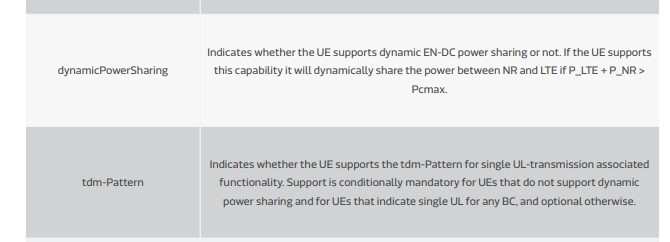What if both LTE and NR demands high UL power?
I think there must be some max power configured for each technology.
Thats why @RFSpecialist is not getting power higher than 20 dBm.
I guess it will happen either in LTE or in NR RLC unrecoverable error due maxtxretransmission.
If not enough power available.
here’s a good white paper from mediatek about dynamic power sharing 5G and 5G:

I could not find dynamicpowersharing IE in the log.
Maybe is not a mandatory IE.
We tried tdm but it has many conflict with other process and found SGNB Mod refuse so reverted back to normal setting.
As per 3gpp, UE must support tdm.
DPS is additional feature to have network assisted dynamic power so it need Network and UE support.
As if now all EN-DC user can go only 20 dBm and it is major bottleneck for VoLTE user (EN-DC) and direct 3 dBm loss then normal VoLTE (LTE User).
You’re right, it is not mandatory IE.
White paper above also says that: “MCG has higher priority than SCG for power allocation. The reason is that the control plane signaling will go through MCG mainly, thus the uplink coverage of MCG shall be guaranteed.”
We did reverse trail where we gave Max NR Uplink power=21/22 dBm with cost of LTE power reduction 17 dbm to maintain total 23 dBm.
But it is not feasible either way.
You need strong LTE signalling in uplink + NR power as well.
So best setting is 23 dBm (total) and LTE & NR max 20 dBm without DPS.
Huawei has a feature to deactivate NR when VoLTE call occurs for this reason I believe.
But as iPhone and other major handset vendors ask to have VoLTE + NR so we are not having any choice.
This is OEM feature, not a phone feature. Simply scg is released when VoLTE is initiated.
If feature is activated.
This way 3 dB is gained in VoLTE link budget without NR.
Agree, but handset vendor is having one scenario where they will check VoLTE + NR thrput (1 gbps) in case of 100MHz. On network side, there are many setting to manage VoLTE + SCG addition / B1 restriction under “PSCell Management for VoLTE UEs”.
For VoLTE UEs, three independent PSCell management modes are supported. The PSCell management mode to be used is specified by the NsaDcMgmtConfig.VolteUeScgMgmtStrategy parameter.
If the NsaDcMgmtConfig.VolteUeScgMgmtStrategy parameter is set to VOLTE_PREFERRED and the SgNB has been configured, the eNodeB releases the SgNB immediately after a VoLTE service is initiated. If no SgNB is configured, the eNodeB will not trigger an SgNB addition before the VoLTE service is released. If the NSA_DC_VOLUME_BASED_SCG_ADD_SW option of the NsaDcMgmtConfig.NsaDcAlgoSwitch parameter is deselected, the eNodeB will trigger an SgNB addition immediately after the VoLTE service is released.
If the NsaDcMgmtConfig.VolteUeScgMgmtStrategy parameter is set to ADAPTIVE and the SINR of a newly initiated VoLTE service is smaller than the value of NsaDcMgmtConfig.UlQualityThldForScgRelease or the uplink/downlink packet loss rate of the VoLTE service of QCI 1 is greater than the value of NsaDcMgmtConfig.VoltePlrThldForScgRelease, the eNodeB immediately releases the SgNB if it has been added. If no SgNB is configured, the eNodeB will not trigger an SgNB addition before the VoLTE service is released. If the NSA_DC_VOLUME_BASED_SCG_ADD_SW option of the NsaDcMgmtConfig.NsaDcAlgoSwitch parameter is deselected, the eNodeB will trigger an SgNB addition immediately after the VoLTE service is released.
After the UE is handed over to a cell, the base station determines whether to add an SgNB or delete the SgNB if it has been added, based on the SINR measurement result or uplink/downlink packet loss rate of QCI 1 services in this cell.
If the NsaDcMgmtConfig.VolteUeScgMgmtStrategy parameter is set to VOLTE_SCG_COEXISTENCE, the eNodeB does not process VoLTE services as it does in the preceding two modes.
For VoLTE services, when NsaDcMgmtConfig.VolteUeScgMgmtStrategy is set to VOLTE_SCG_COEXISTENCE, the VOLTE_NSA_DC_IF_NR_MEAS_SW option of the NsaDcMgmtConfig.NsaDcAlgoSwitch parameter specifies whether the eNodeB delivers NR B1 measurement configuration for SgNB addition. If this option is deselected, the eNodeB does not deliver NR B1 measurement configuration for SgNB addition, thereby preventing VoLTE services from being affected. If this option is selected, the eNodeB delivers NR B1 measurement configuration for SgNB addition.
Yes, so VOLTE_PREFERRED is the good option to keep a normal link budget in uplink for VoLTE.
Agree. If you don’t want any NR PS service while having VoLTE.
VoLTE service should guaranteed.
Thanks for detail info @ajaymsfather.
I will check Samsung implementation.
We are using -105dBm to N1
For N78 I recommend -95dBm.
We’ve seen that Huawei has multiple solutions for this 3 dB lost in VoLTE link budget in uplink due to NR. How about Nokia and Ericsson?
Do they have a solution?
At least a basic solution: to disable NR as soon as VoLTE is initiated?
Dear Ericsson, Nokia expert… please share the functionality & control available for VoLTE + NR (Restriction, B1 config, resume strategy post VoLTE call).
Huawei possible solutions are mentioned in above messages.
In Ericsson we have feature for this.
VoLTE split bearer support.
Split per UE allowed or not allowed can be configured and has priority over any ARP configuration.
This allows Operator to configure bearers to allow split bearer in combination with VoLTE. We are achieving this by setting paramaters on QCI profile IN EN DC.